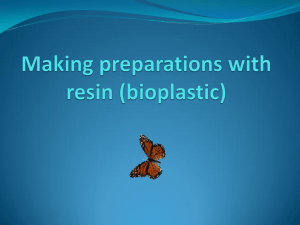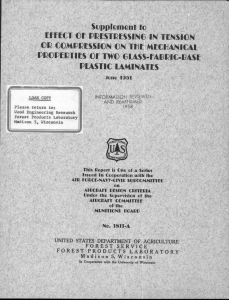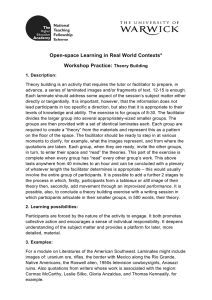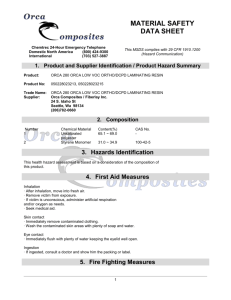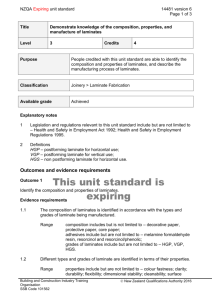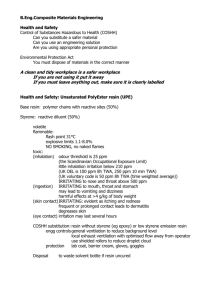MKT OF DIFFERENT CATALYSTS AND AMOUNTS Of STYRENE MONOMER ON
advertisement
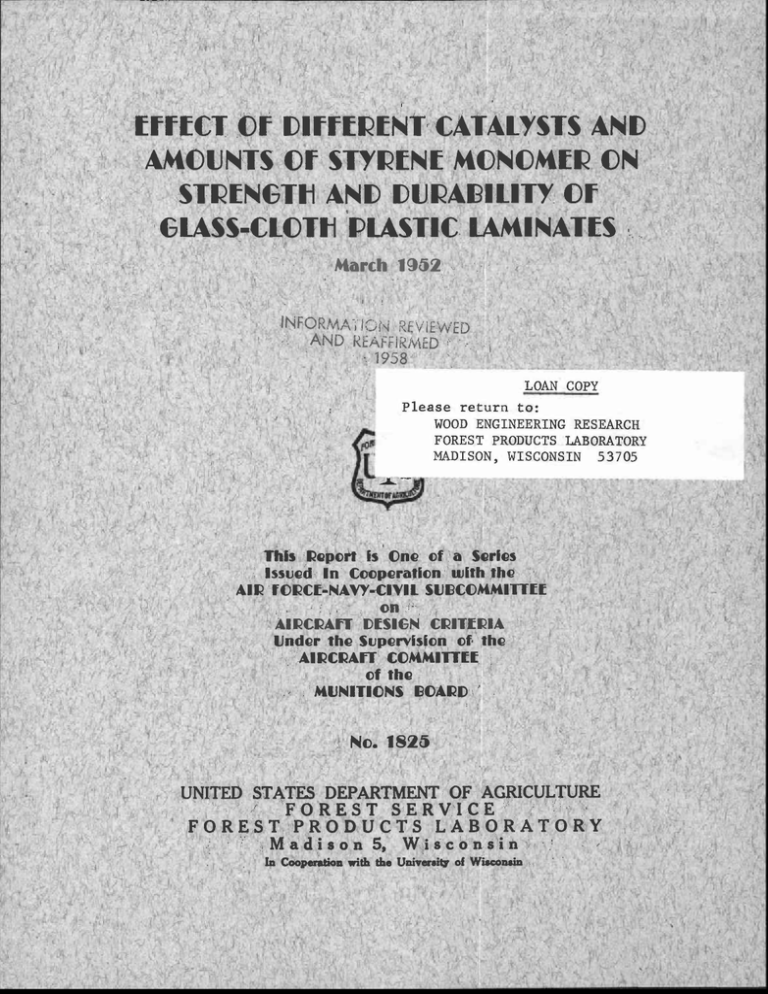
MKT OF DIFFERENT CATALYSTS AND AMOUNTS Of STYRENE MONOMER ON STRENGTH AND DURAIBILITY Of GLASS-CLOTH MASTIC LAMINATES March 1952 INFORMATION REVIEWED AND REAFFIRMED 1958 LOAN COPY Please return to: WOOD ENGINEERING RESEARCH FOREST PRODUCTS LABORATORY MADISON, WISCONSIN 53705 This 'Report is One of 'a Series Issued In Cooperation' with the AIR FORCE-NAVY-CIVIL SUBCOMMITTEE on AIRCRAFT DESIGN CRITERIA Under the Supervision of the AIRCRAFT' COMMITTEE of the MUNITIONS BOARD, No. 1825 UNITED STATES DEPARTMENT OF AGRICULTURE 1 FOREST SERVICE FOREST PRODUCTS LABORATORY Madison 5, Wisconsin In Cooperation with the University of Wisconsin EFFECT OF DIFFERENT CATALYSTS AND AMOUNTS OF STYRENE MONMER ON STRENGTH AND OF GLASS-CLOTH PLASTIC DURABILITY LAMINATES1 By A. A. MOHAUPT, Technologist and A. D. FREAS, Engineer Forest Products Laboratory, 2 Forest Service U. S. Department of Agriculture SiLmmary Static bending and Izod impact tests were made to determine how the strength and durability of glass-cloth plastic laminates were affected when the resin formulation was varied as to curing conditions, amounts of catalyst and accelerator, and amounts of styrene monomer added to the resin. Laminates made with three typical polyester resins were tested after various types of exposure. Because of the large number of variables covered in the study and the relatively small number of tests for each variable, positive conclusions cannot be drawn. The conclusions given should therefore be considered only as indicative of trends. Increasing the amount of catalyst or increasing or decreasing the styrene monomer content from the manufacturers' recommendations for some typical resin formulations used to make glass-cloth plastic laminates resulted in relatively small changes in static bending strength for the test conditions studied. These conditions included standard conditions (73° F., 50 percent relative humidity), water immersion for 30 days, outdoor weathering (3, 6, and 12 months), 10 cycles of alternating low and high relative humidity at 175° F., 1/2 hour at 160° F., 1/2 hour at 350° F., and 192 hours at 350° F. Decreasing the catalyst content by 50 percent resulted in some loss in bending strength at standard conditions, after water immersion, after the cyclic exposure, and after 1/2 hour at 160° F. Heat-curing combinations of -This progress report is one of a series prepared and distributed by the Forest Products Laboratory under U. S. Navy Bureau of Aeronautics Order No. NAer 01044 and U. S. Air Force No. USAF (33-038) (51-4066-E). Maintained at Madison, Wis., in cooperation with the University of Wisconsin, Rept. No. 1825 -1- Agriculture-Madison catalyst and resin (using manufacturers' recommendations) appeared to produce better laminates than the room-temperature-curing combinations. In most cases a reduction in bendin strength resulted from exposure to the weather, elevated temperatures, immersion in water, and a cyclic exposure of alternating high and low relative humidity at 175° F. The reductions due to exposure were greater than the effects resulting from variations in catalyst and styrene monomer content. The modulus of elasticity was affected least by these exposures; the modulus of rupture was decreased considerably more; and the strength at proportional limit was reduced most. Introduction The purpose of this work was to determine how the strength and durability of glass-cloth plastic laminates were affected by variations in the amounts of catalyst and styrene monomer in some typical polyester resins. In the fabrication of glass-cloth plastic laminates with currently used polyester resins, variations in the amount of catalyst may occur either accidentally or because of efforts to control the tank life or the gel time of the mixed resin. The proportion of styrene monomer may also be increased or decreased from the manufacturer's recommendation in order to change the viscosity and spreading properties of the mixed resin. These chances may be made because of the be-, lief that styrene monomer is primarily a solvent or thinner rather than an integral reactive component of the resin system. The proportion of styrene monomer may also change because of evaporation in a mixture used over a period of time. An attempt to determine the effect of such variations was made in this work by varying the percentages of catalyst and styrene monomer so that both larger and smaller quantities were used than those normally recommended by the manufacturer. Resin Formulations Three typical polyester resins, one with and two without incorporated styrene monomer, were used to make 28 glass,-cloth plastic laminate panels for test. Of these, 20 panels were made with resins in which the catalyst content was varied and 8 were made with a resin in which the styrene monomer content was varied. Variation in Catalyst Content Two typical polyester resins were used to determine the effect of variations in catalyst content. Resin 2 was a laminating resin of the polyester (styrenealkyd) type reported to contain styrene monomer. Resin !. was a laminating resin of the same type furnished by the manufacturer without incorporated styrene monomer. The compositions of the resin formulations and their curing conditions are given in table 1. Rept. No. R1825 -2- Variation in Styrene Monomer Content Only one polyester resin was used to determine the effect of varying amounts of styrene monomer on strength of glass-cloth plastic laminates. Resin 3, a laminating resin of the polyester type to be incorporated with styrene monomer, was chosen because the component parts were furnished separately by the manufacturer. The formulations and curing conditions used are given in table 2. Fabrication of Test Panels For each resin formulation, one test panel 1/8 by 18 by 18 inches was fabricated for bending specimens and one panel 9/16 by 8 by 8 inches was made for Izod impact specimens. The fabrication procedure was varied for some panels in , order to keep the resin content between 35 and 45 percent. The 1/8-inch laminates consisted of 12 plies of 181 glass cloth, finish 114, p arallel laminated. After the desired number of plies were laid between cellophane-covered aluminum cauls and impregnated with resin, the assembly was placed in a press and cured at a pressure of 14 pounds per square inch. For resins cured at 250° F., an initial platen temperature of 220° F. was maintained for 20 minutes and then at 250° F. for 30 minutes. Laminates 6 and 7 (table 1) were partially cured under 14 pounds of pressure per square inch at 160° F. for 15 minutes and removed immediately from the press, the final cure being completed at room temperature without pressure. The laminates made with the room-temperature-setting formulations were cured in a press at approximately 75° F. for 16 hours under a pressure of 14 pounds per square inch. For the 9/16-inch-thick laminates made with the resin formulations cured at 250° F„ the fabrication procedure was the same as that used for the 1/8inch-thick laminates, except that the pressure was reduced from 14 to 8pounds per square inch. The thickness of the panel was constantly checked with a dial gage and bracket attached to the platens of the press. Pressure was likewise reduced for the laminates made with resin formulations cured at room and intermediate temperatures. This reduction in pressure was necessary in order to obtain approximately the same resin content as in the 1/8inch-thick laminates. If 14 pounds per square inch had been applied to the 9/16-inch laminates throughout the curing cycle, both resin content and panel thickness would have been less than desired. Test Specimens Two types of test specimens, static bending and Izod impact, were used to evaluate the glass-cloth plastic laminates made with the various resin formulations. The static bending specimens were approximately 1/8 by 1/2 by 4 inches and were similar to the specimen shown in Federal Specification LP406a, Method No. 1031. The Izod impact s pecimens were cut from the Rept. No. R1825 -3= 9/16-inch laminates so that the warp direction of the cloth was parallel to the length of the specimen and the notch was perpendicular to the plies of cloth. The specimens were cut to within the tolerances specified in Federal Specification LP406a, method 1071 (fig, 1). All static bending specimens were cut from the 1/8-inch laminates with a table saw having a coarte=grit car'eorundum wheel, The method of cutting specimens from the panels is shown in figure 2. Each test specimen was marked in accordance with its position in the panel, and then five specimens were selected for each exposure condition except outdoor weathering. Sections 4-1/2 by 5 inches in size were weathered and five bending specimens cut from these sections after exposure, Exposure and Conditioning of Test Specimens After the test panels were removed from the press, they were conditioned at 73° F. and 50 percent relative humidity for a week or longer. A long conditioning period was especially necessary for the panels made with roomtemperature-setting resin formulations; because almost a week was required to attain the maximum Barcol hardness, The exposure conditions to which the bending specimens were subjected are as follows: (1) Standard room-temperature conditions. -- After suitable conditioning, a group of five bending specimens was tested at room temperature (73° F. and 50 percent relative humidity). These specimens were used as controls for comparison with those subjected to other exposure conditions. (2, 3, and 4) Outdoor exposure. -- For outdoor exposure, two sections of each panel, about 4,1/2 by 5 inches in si7e, were placed on a rack on the roof of the Forest Products Laboratory for 3, 6, or 12 months. The racks consisted of a framework constructed so that the weathering panels were exposed facing south at a 45° angle. The small sections for weathering tests were fastened by a hook-and-spring arrangement to allow free air circulation on both sides. A summary of the weather conditions during the exposure period is given in table 3 4 After exposure, five static bending specimens were cut from each panel and reconditioned at 73° F. and 50 percent relative humidity for at least 48 hours. Immersion in water. 44 Specimens were submerged in tap water at room (5) temperature for 30 days, and removed just before being tested, (6) Ten cycles, alternating low and high relative humidity, at 175° F. -Test specimens were exposed to the accelerated service tests as described in Federal Specification LP406a, Nethod 6011, cycle IV. Each cycle consisted of 24 hours at 175° F. over water followed by 24 hours at 175° F. in an oven with circulating air. At the conclusion of the 10-cycle exposure, the specimens were reconditioned at 73° F. and 50 percent relative humidity for at least 48 hours. (7) Exposure to 160° F, for 1/2 hour. -- Five bending specimens were exposed to 160° F. for 1/2 hour and tested in an insulated box that housed the testing Rept, No. 1825 -4- equipment. The box included heating elements and controls for regulating the temperature, which was maintained at 160° F. for this exposure and test, (8) Exposure to 350° F. for 1/2 hour, .- Specimens were exposed as in exposure (7), except that the temperature controls were set at 350° F. instead of 160° F. (9) Exposure to 350° F. for 192 hours. The same apparatus was used for this exposure as for exposure (7), but the specimens remained in the insulated box for 192 hours at 350° F, and were tested for bending strength at that temperature, Method of Test The 1/8-by 1/2- by 4-inch static bending specimens were tested on a 2-inch span under center loading, The radius of the loading blocks and supports was 1/4 inch. Deflection at the center of the span was measured with a dial gage reading to 0.001 inch and arranged so that its spindle contacted the bottom of the specimen at midspan, The maximum rate of head movement of the testing machine, according to Method 1031 of Federal Specification LP406a, would be 0.053 inch per minute, It was found feasible to test only the control specimens at this speed. In order to obtain the necessary deflection readings on specimens exposed to other conditions, a speed of about 0,025 inch per minute was used, Tests at room temperature were generally made under uncontrolled conditions of temperature and relative humidity. Specimens were, however, exposed to these conditions for as short a time as possible. The specimens exposed to high temperature were tested in an insulated box or oven maintained at the desired temperature. Izod impact tests were made and tested in accordance with Method 1071, Federal Specification LP406a. Barcol hardness of all the 1/8-inch laminates was determined as an indication of the completeness of the cure, especially where room-temperature accelerators were used. Readings were taken irregularly at intervals over a period of 3 weeks, Weights and linear measurements were also taken on the laminates in order to calculate the specific gravity and resin content for comparison purposes. ReDt. No. 1825 Results of Tests Results of the tests are summarized in tables 4, 5, and 6 and presented graphically in figures 3, 4, and 5. By changing the fabrication procedures, the variations in specific gravity and resin content of the laminates were held to a minimum. The maximum variation in specific gravity was 4 percent and that in resin content 4.3 percent, The individual values for each laminate are given, together with average thicknesses and Barcol hardness readings, in table 4. Effect of Variations in Catalyst At standard conditions (73° F., 50 percent relative humidity).--The effect of the amount of catalyst on static bending strength after exposure to 73° F. and 50 percent relative humidity is shown in table 5 and summarized in table 7. With resin 2, when cured at 250° F. (as in laminates 1, 2, and 3, table 5), there is a slight increase in modulus of rupture with increased amount of catalyst above the manufacturers' recommendation. A decrease in the amount of catalyst of 50 percent below the manufacturers' recommendation caused a marked reduction in modulus of rupture. The increase between 0.8 percent and 1.2 percent catalyst content is only about one-fifth that between 0.4 percent and 0.8 percent, indicating a decreasing effectiveness for increasing additions of catalyst greater than 0.8 percent. The trend for stress at proportional limit is similar to that for modulus of rupture, but that for modulus of elasticity is much less marked. When laminates were cured at lower temperatures (75° and 160° F., as were laminates 4, 5, 6, and 7) the addition of promoters to the recommended amount of catalyst (0.8 percent benzoyl peroxide) resulted in very little change in strength properties. The formulations produced tower strength properties, however, than did the formulations cured at the higher temperature without a promoter (laminate 2), but were somewhat better than the laminate made with a reduced amount of catalyst (laminate 1). The Barcol hardness readings of the laminates made with a promoter (laminates 4, 5, 6, and 7) were lower than those made without a promoter (laminates 1, 2, and 3). With resin 4 (laminates 8, 9, and 10), an increase in strength properties with increased catalyst and promoter is indicated. The increase in stress at proportional limit is considerably greater than in modulus of rupture, which shows an increase, over the range tested, of only about 8 percent. The properties of laminate 10 are about the same as those of laminate 2. The izod strength properties (table 7) are erratic and somewhat conflicting, and it appears that no definite trend exists. After outdoor exposure.--Contrary to the trend exhibited at standard conditions, an increase in the amount of catalyst in those laminates cured at high temperature (laminates 1, 2, and 3) resulted in moderately decreased strength after outdoor exposure. Consequently, the laminates with the lower Rept. No. 1825 -6- percentages of catalyst retained the higher proportions of their standardcondition strength. The laminates made with resin 2 and a promoter and cured at 75° F. or 160° F. (laminates 4, 5, 6, and 7) showed essentially the same trends, regardless of the amount of promoter added or the curing temperature. After outdoor exposure for 12 months, the strength properties were practically unaffected and somewhat higher than the strength properties, particularly modulus of rupture and stress at proportional limit, of the laminates (1, 2, 3) cured at high temperature. The laminates made with resin 4 and a promoter and cured at room temperature (laminates 8, 9, and 10) showed no consistent trend with the amount of promoter. In general, they retained their standard-condition strengths after outdoor exposure except for stress at proportional limit, which was reduced by various inconsistent amounts. After water immersion.--The laminates made with resin 2 and cured at high temperature (laminates 1, 2, and 3) showed small increases in strength with increasing amounts of catalyst. Modulus of elasticity showed no reduction after the exposure, stress at proportional limit was reduced about 50 percent, and modulus of rupture about 30 percent as compared with the values at standard conditions. Of the laminates made with resin 2 and a promoter and cured at 75° F., laminate 5, with the larger addition of promoter, gave slightly higher values of modulus of rupture. Modulus of elasticity was unaffected, while stress at proportional limit showed a small decrease. The corresponding laminates cured at 160° F. (laminates 6 and 7) gave essentially the same results for the two amounts of promoter. Strength properties were in about the range shown by the laminates (1, 2, 3) made with the same resin but cured at high temperatures. The effect of water immersion on strength properties of laminates 6 and 7 also was a'7out the same as on the properties of the laminates cured at high temperature, as shown by comparison with values at standard conditions. The laminates made with resin 4 and a promoter and cured at room temperature (laminates 8, 9, and 10) showed moderate increases in strength properties with increasing amounts of promoter. Modulus of rupture was decreased about 40 percent and stress at proportional limit about 50 percent as compared with the values at standard conditions. After cyclic exp osure.--The laminates cured at high temperature (1, 2, and 3) showed increasing strength under this exposure with increasing amounts of catalyst. Since the trend was similar to that under standard conditions, about the same percentage of standard-condition strength was retained, regardless of the amount of catalyst added. The laminates made with resin 2 and a promoter and cured at 75° and 160° F. (4, 5, 6, and 7) showed no specific trends, except that those cured at 160° F. retained somewhat smaller percentaEes of their standard-condition strength than did those cured at 75° F. This may result from additional curing Rept. No. 1825 -7- during the exposure, those originally cured at the lower temperature receiving the greater amount of additional cure. Stren gth properties were in about the same range as for the laminates cured at high temperature, The laminates made with resin 4 and a promoter and cured at room temperature (3, 9, and 10) indicated slightly decreasing strength-property values (except for modulus of elasticity) with increasing amounts of promoter as well as decreasing retention of standard-condition strength. After exposure to high temperature,--After the 1/2-hour exposure at 160° F., the laminates made with resin 2 and cured at high temperature (1, 2, and 3) showed both increasing strength and increasing retention of strength with increasing amounts of catalyst. A somewhat similar trend of strength properties, but at sharply reduced levels, was exhibited after 1/2 hour at 350° F. Little difference among the three was shown after 192 hours at 350° F. The level of strength properties was somewhat lower after 192 hours than after 1/2 hour at 350° F., the greater differences occurring with the larger additions of catalyst. The laminates made with resin 2 and a promoter and cured at 75° F, (laminates 4 and 5) had strengths at about the same level after 1/2 hour at 160° F. despite the-difference in promoter content, The laminates cured at 160° F. (laminates 6 and 7), however, showed lower strengths with the larger amount of promoter. Strength properties and retention of strength were slightly higher than for laminate 1 and considerably lower than for laminates 2 and 3. After 1/2 hour at 350° F., the two laminates (4 and 5) cured at 75° F, showed sli ght increases in strength properties with increases in amount of promoter, but the opposite was true for the laminates cured at 160° F. Strength levels of laminates 6 and 7 were considerably lower than for the laminates (1, 2, and 3) cured at 250° F. Exposure at 350° F. for 192 hours apparently resulted in additional cure for laminates 4, 5, 5, and 7, since all strength properties were generally higher than after exposure at 350° F. for 1/2 hour. Increased amounts of promoter also resulted in increased strength after the longer exposure at 350° F.; the laminates cured at 160° F. showing higher strength than those cured at 75° F. and generally a higher modulus of rupture than the laminates cured at 250° F., other properties being about the same. The laminates made with resin 4 and a promoter and cured at room temperature (8, 9, 10) showed increasing strengths with increasing amounts of promoter after exposure at 160° F. for 1/2 hour, but generally the reverse was true for the two exposures to 350° F. Actual strengths and retentions of strength were generally higher than for the laminates made with resin 2, particularly after exposure at 350° F. Effect of Variation in Styrene Monomer Content Addition of styrene monomer to resin 3 (laminates 11, 12, 13, and 14) appears to result in moderate increases in strength properties after exposure at 73° F, and 50 percent relative humidity. For all strength properties given in table 7, the panels made with 33 percent of styrene monomer (laminate 14) Rept. No. 1825 -3- added to the resin show an increase of about 5 percent over those made with no styrene added (laminate 11). Increases in styrene monomer content (laminates 11, 12, 13, and 14) appear to have little effect on weather resistance, although there is some indication that the larger styrene additions result in slightly lower strength retention after outdoor exposure. Resistance to moisture does not appear to be affected by the amount of styrene monomer added. After exposure to 160° F. for 1/2 hour, strength properties increased with added styrene monomer, the greatest difference being between the laminate made with resin containing no styrene monomer and that made with resin containing 11 percent. In the 1/2-hour exposure at 350° F., no trends of strength with styrene content are apparent. After 192 hours at 350° F., the laminates made with the larger amounts of styrene monomer were generally lower in strength, Conclusions 1. Increasing the amount of catalyst above the manufacturer's recommendations by 50 percent in laminates made with resin 2 and cured at 250° F. resulted in no significant change in strength after any of the exposures, except after. exposure at 160° F. for 1/2 hour.' A 50-percent decrease in the amount of catalyst below the manufacturer's recommendations resulted in a loss in strength, primarily at standard conditions, after water immersion, after the cyclic exposure, and after 1/2 hour at 160° F. and 350° F. 2. Increases in the amount of promoter added to resin 2 in general resulted in no significant change in strength for laminates cured at 75° or 160° F. except after exposure to 350° F. for 192 hours. 3. Increases in the amount of promoter added to resin 4 resulted in no significant trends in strength for laminates cured at room temperature. Laminates made with resin L, however, had higher strengths and higher retentions of strength after exposure to 350° F. than those made with resin 2. 4. Addition of 0 to 33 percent of styrene monomer to resin 3 resulted in no significant effects on the strength properties of the laminates, 5. Glass-cloth plastic laminates fabricated with resins cured at high temperatures had slightly higher hardness and static strength than did those made with the same resins formulated with promoters in order to cure at lower temperatures. 6. The modulus of elasticity was reduced less by exposure to various conditions of temperature and moisture than the modulus of rupture and the strength at proportional limit; and the modulus of rupture was affected less by these conditions than the strength at proportional limit. 7. Exposure to the weather generally resulted in no reduction in static strength properties for laminates made with resins containing promoters. For the laminates made with resins not containing promoters, there were some reductions in moduli of rupture and elasticity after outdoor exposure. Rept. No. 1825 -9- Table 1.--Catalyst content and curing conditions of glass-cloth plastic laminates tested for effect of catalyst content variations on bending strength Resin number nate : number: Catalyst Curing conditions? : Amount : of : Time :catalyst: Tempera, : • 1ure t ' Hours '• Minutes • used- :Percent : 1 : 2 3 • Benzoyl peroxide . 3 . 2 ▪ Benzoyl peroxide . Promoter 24 5 2 6 2 • Benzoyl peroxide : Promoter 2A 7 : 2 : Benzoyl peroxide • Benzoyl peroxide • Promoter 2k • 220-30 2220-250 220-30 1.2 .8 • 4.0 .8 : .6 75 16 160 : .. 15 : 75 16 75 16 2.4 1.8 75 : 16 7.2 Based on weight of resin. ?Lower temperature maintained for 20 minutes, higher for 30 minutes. P ercent recommended by manufacturer. An organ-metallic derivative. 51-hydroxycyclohexyl hydroperoxide-l. Rept. No. 1825 • 15 160 .9 2.0 4, plus 22% : Catalyst 1,HCB-12 : 1.2 styrene • ' Promoter 11L • -48 10 1 4, plus 22% ' Catalyst 1-HCH•-1 5- : styrene '. Promoter 11 • . • 16 75 2 .0 • Promoter 2 411.0 8 e 4, plus 22;• Catalyst 1-HCH-14 styrene ▪ Promoter 1- 1 ?20-30 • •2 .8 . -220-250 .8 . Benzoyl peroxide 4 ; 2 9 • • 2 0.4 : -220-250 • : Benzoyl peroxide : 2 . 2 ° F. •• • • •• • • • Table 2.--Styrene monomer content and curing conditions of glass-cloth plastic laminates tested for effect of variations in styrene content on bendin: strength : Curing conditions? Laminate : Resin : Styrene monomer : Catalyst number : number : content :(benzoyl peroxide): :Temperature: Time of resin : - : Minutes Percent ° F. Percent 0 1.2 3 : 1.2 3 : 12 -22 1.2 3 : 1.2 3 : 33 : 220-250 : 20-30 : 220-250 : 20-30 : 220-250 : 20-30 20-30 : 220-250 -Normal amount recommended by the resin manufacturer. 2 -Lower temperature maintained for 20 minutes, higher for 30 minutes. Table 3.--Summary of weather conditions for the period May to November 19501" Month : Temperatures :Average :Precipitation:Possible sunshine :----- ---- :relative: : :Maximum:Minimum:Mean:Normal:humidity:Total :Normal: Mean : Normal . : : mean : • 9May 2 June • 9July. 2 August : September: October : November : ° F. : ° F. •° F.: ° F. :Percent :Inches:Inches:Percent: Percent • . .. .. : : : 30 :57.9: 57.6 : 63.5 : 3.43 : 3.85 : : 75 : 56 87 : 42 :65.7: 67.2: 67.0 : 5.24 : 3.76 : 75 : 75 : 45 :69.7: 72,1: 68.8 :10.93 : 3.88 : 76 : 70 91 : 65 : 65 39 :66.2: 69.8 : 73.8 : 2.69 : 3.21 : 80 : 30 :60.9: 61.4: 77.0 : 2.09 : 3.72 : 61 : 57 82 : 65 : 32 :54.7: 49.3. 71.2 : 1.23 : 2.43 : 53 74 : -8 :30.8: 34.2 : 68.5 : 1.04 : 1.78 : 41 : 39 1Data taken from meteorological summary at Truax Field Airport Station, U. S. Weather Bureau, Madison, Wis. Rept. No. 1825 Table 4.--Physical properties of 1/8-inch glass-cloth plastic laminates Lami.:Resin:Benzoyl : nate: nurn-:peroxide: num-: bor :catalyst: ber : : :Percent : Other additions Percent : • :Curinc;:Average1:SpecificZ:Resin2: BarcolL1 : tem- : thick- : gravity : con- :hardness : pom . : ness : : tent : : tune : : : : : ° F. : Inches : : .. : 25o : 0.130 : .127 : .131 : : Per- : : 9E : 0.4 .8 : : _... -- : : : 1.2 : -- : 250 : 250 : : 1 75 : 75 : .133 : .135 : 1.77 1.76 : 39.4. : 40.3 : 61,0 : .8 .8 •. : : 2.0 - Promoter 2: : 4.0 - Promoter 2: •. 2 2 2 2 : .8 : 2.0 - Promoter 2: . 4.0 - Promoter 2: 160 : 160 : .136 : 7 : 1.76 1.76 : 40.4 : : 39.8 : 61.0 62.1 8 . 9 : 4 4 4 : : : : 2.4 : 4.8 : 7.2 . : 0 :11.0 :22.0 :33.0 75 : 75 : 75 : . 250 : 250 : 250 : 250 : .134 : .125 : .125 : . .130 : .128 : ,128 : .126 : 1.82 : 37.6 : : 36.3 : 61.5 61.4 1 : 2 : 3 : 4 : 5 : 6 : 10 ; : 11 : 12 : 13 : 14 : 2 2 2 .8 3 .6 1.2 -1.8 . 3 3 3 3 : : : : 1.2 1.2 1.2 1.2 - Promoter 1: - Promoter 1: - Promoter 1: . - Styrene : - Styrene : . Styrene : - Styrene : .135 : 1.77 1.78 : 37.8. : 37.0 : 1.75 : 37.8 : . 1.79 1.79 64.6 66.9 66.9 . 61.0 62.0 1.81 : 36.1 : . . : 39.3 : 1.81 1.78 : 38.5. : 37.5 : 65,0 65.1 65.1 1.78 : 36.5. 65.1 1Average of 36 readings, ?Calculated from weights and dimensions of laminate. 3 -Calculated from weight of laminate and calculated weight of glass cloth. 4 Average of 10 readings. 5 7-Catalyst eras 1-hydroxycyclohexyl hydroperoxide-1. Rept. No. 1825 Rgg m 1,U „UR g n nail m. .;,,n,_ 1,41 1n 2 Ht., am, gEg th m ,.:. NE .kk 1°1 W.„ uk. -qi-'4i--WL-qk"" 'ffi. i g4 i ';-- i .a7:.:i P wi vq.k.,A '.' .A...z.z•,:.;.t -.,,;F Pp r.;:i.% 'P' '.; 1a 427.g1- - ';,:w ..;2- .-;z? 4 .E l j • 7 41 g E g A g UA, g U g M g EUA U4H.EA agi..s' Env. mv. §,, • H.7.,, akar, §R,E, . 7, 7A " .7 4 ..7. 4.-n.:1 — .-1.n 8 , , ggc g 88 2RR 82 8 pa §c-8 g gg ..gg 88R r-,12, at . . 1 2 ..., ,,o, Ill NV) C., •11,0 •• 0 N , ON H .4,0 0 ,-1 14,4-1 0 ,I katO ,I) W.C1 ... ..,1 -: , .A.r:n ... ‘47.. ,..-:n SS .SS,.S' ..S..c;,;' nnn -,,A, .i.: tZrl. .S.n .7ww: 74 .-n.S.n :' ,..r7' .. ,qP, w,.. i q LiAtV2n., T8monnn 2 28t2 .28co PtRn g .n .P8.n 4. 8Vio, h: hajj NI1101 aaa nnn8:882 n.n nnn nn, nnn ,n. hi 5___:7:! .. MI HP i gAn HE ,^ F..§.1 igin .4 aa-cli tgzatIR W% '.'9a§V H12 Elk USA mvs auf., n , 44 .. .. .. .. .. .. _ .. .. .. .. .. .. .. .. .. .. .. .. .. .. . .. .. .. .. .. .. .. .. .. .. .. .. .. .. .. .. _ .. .. .. .. .. .. .. .. .. .. .. .. .. .. .. .. .. .. .. .. .. .. .. .. .. ... 7 .. _ .. 6 . . Mn H.§.. Mn- m 88 a m aaao. mn g an8°8 .8n. 8 a N 88 888 wm,,888 o-,..,8, at-, 88 a 2 a .,--n Ti.t, t g,, .7, 1.:d"i'cr7i i giC ..-,:d..0 . .. .. .. .. .. .. .. .. .. .. .. .. .. .. .. .. ..... . 1 alg -1 akK - ki „.— W - HE - M. - i3O:iii: - a g E - W:, at% aapa §asL 1 1 1 ..4 -L ,i,i,i :41 .-i4.-i .-14.4 g ts.o.4' 1 s ;:1,..scic4:_kz:?:C.J,jr,T4..-r...7._;-1-,-?::_!---!7_-.W.._7=_A..:n______ 413 1 7..... 4 gd _. mg aum g 4 al-,s c$,U p. g U yi Ugg na 1R4 Uhl aaa ..H1? -4.4 ...-z .. aaa4- ..aacaS .-z,z,z FrnHR ..-z4-7 -za,-; aaa aaa aaa U.E.....-.7-. 4..;. ..z gaa„; aaa 3aaa 1 1 .. .. .. .. .. .. .. .. .. .. .. .. .. .. .. .. .. .. .. .. .. .. .. .. .. .. .. .. .. .. .. .. .. .. .. .. .. .. .. .. .. .. .. .. .. .. .. .. .. .. .. .. .. .. .. .. _ .. .. g 6 • an, aaa. am, nac,: an, pnac,, au. m aak 2 m, pm. au, an, m. 1 .,....7 - .,.i.i.?:.- $:, pi ,s ,,, - .,,,;.-:^ ip,§-.r.. - pr,,r7ip:- ,,r ,.t-, Fe- -..6.,,7..,-4.g ,sC000.C'. , i,.;p7 --;.--;- :1_ - ,,17 ::,, ,cu- i,,, ;:r -- ,..., §88, 888 8g8 gg§ 888. 888 82§ §88 g88 g88 888 pg 88g .0 1.; * SS1°' f;4!°' SM R ".9-rE* ag8 a" kia .d• • n g !At& Hl g '!11:-:1R c* - - na — n 8 8 - 1§ . 'VA& t!A t In t B1 8t St!'g P" gg,§ § 88= 81 3:41R nF.A We..* - V. - . .1"; .;?; • A f,H8 aaa 5i3t"c.aa g iUa .; UA M M nn, nnn Hgo. PA l g kaRP 2 t8..8.* g'Pl* Mcai .;aa aaa aaa aaa Ug, n §U, „•7 ,3,6 0 M. gnn, s4-4 = nn, nnn nn, nnn nnn" nnn n.n n.n UKR Utqs aah @Fla na^ PgR 8gg,..- Mrs Ha g g H s' a g8 R gg-a aaa VARa aaa §1:11 Ii;;; aaa' aaa' aaa' aaa 2aaa' aaa' aT7Lc:i na an §88 8K 8 §- 8e 888 8g8 gg§ 888 g88 8gg 888 888 888 / n n74.1?, ;C:, A VR t;'," R R nA/ 3! 11-'2 §8§ 8§§ 8§§ g§8 8§8 agg 828 888 888 828 888 g 11 1x 1 0 1:g P..,la .9.,, FAN na g g . Ma nig E-a2 U I ..§H8 KE1 ,I g h- EF,,g ,84 § 3,18 , Nar& ...!TL......7.n...„.7.WWN....NNN....02Na'..NNNaaa'..070.7NN'.0;aa7 NNN .Vg. V. 0' n .: Mo k88, WN kUN Ha, §M Pa , f-I I, 8 aa N,,g, 0,70, ,08 ,ON 8 I"8 a§ .§§._—, /•,;-/ !;75,-s 1 mi,- r,- ,,,n g,s,vn .--ITR7. APR' 'RTNA' nn ..i, R g T f',\;A gs15,s 2 4 2 .9.. 08,,, .ti5".'r i--; ,J- !I an, an an, m pa g § lia M M. M, Mc. M., M..- M. M., 6 l' ql4 ,-.4-..FAlL..1....??)4,:4....SqR".....!.......W...M....W).................. F mg, kM g _M8,2 afRR MR kM& ia\E" .§ia g g ns H4 Ma Mc g Ra Y,'H2 . Ug8 a.U8 aaa8 aaa8 kka8 aa4 aaa8 aaa8 an8 ?.?-a8 g 8a8 b488 2828 8888 1 ,Hr .s'id" ,-.;',s" . .;in:" F,;di" 1,,,Tdi iii;, iuur" tii.f" ..d,'ii" ,1! 1 4 • • •......... P17,1..i.A.-. I aa4 la4 q3§8 an:1 mg kkkg, an8 a§a8 aaa§ - -U4 82,8,8, 82P1,8 a go g-SI -1 ... Tj .iL, pr. ........... 3 5 s e 1 / ! ii 7 . :1 J?:i....-,fiL ard g RH g Eq, nm „iap p. w,up suN zscu f_,m EM ce,a , im p, nv, f g H E. PE q .41- aaa aaa aaa aaa aaa aaa aaa aaa aaa aaa aaa„u aaa aaa ••aaa . 0, -' •....••••••••••••••••••••••••••••••••••••••••••••••••••••••••••••••••••..•••••••••••••...••••••••••.••••••••_••••••••••••••••••••••••••.. •• •• •• •• •. V 'V g .... :-•-•...,. . z. , ye, ,--...-. .... ..... lel \•-: "el, COT. -S-Z. 11, ---• '-' i 1 . ., 0' 2 g 2 7': . 7; 1 .. ti R k c g 2 2 . .9 t, 4'. 0 2 E. 2 0 2 ° o 11149 FIA.2 Flh ilh OhOh il g PIC III; /IL Oh 11!4, lA g Il.q. - 1 1 TT, l'.1 g ! g ., 1 *i 'i . g . g . g . . t; i g ............m...........4i gg iii4AMAMAMAli g _410:Ali g AMAI4 g Ai g 4A&L! g i s ,. i 12 i gg ;. pg, ! g 'n g tU • -0 , . , E. g •1 n. VVt Aj A Table 6.--Simmary of results of Izod impact tests on glass-cloth plastic laminates made with different resin formulationsLami-: Impact strength nate :---------- Minimum Average number: Maximum : : ..-----: --- -,:..--- -----....---: ----------:Ft.-lb. per in.:Ft.-lb. per in.:Ft.-lb. per in. : : 1 1 : 2 : 3 : 4 5 : : 6 7 8 9 lo : : : : : 11 : 12 : 13 14 : : : 16.0 12.1 12.1 : : : 17.0 12.4 12.3 : : : 15.5 12.0 12.0 15.0 : 15.5 : 14.3 : 14.7 : 14.7 15.1 16.5 17.0 18.9 : : 14.3 15.1 15.7 15.2 : : : : : : 16.0 15.5 15.3 : : : 15.2 15,0 14.6 13.6 : 140 : 12.7 14.9 14.4 : 14.6 14.4 14.6 : : 16.2 14.8 : : : 13.7 14.3 13.8 14.3 ach average value represents the results of Rept. No. 1825 5 tests. Table 7.--Summary of effect of variations in catalyst, promoter, and styrene monomer content of resins on strength properties of glass-cloth 1 plastic laminates: Impact Static bending Lauri-:Resin:Cata-; Pro-:Styrene:Curing:Curing: -: bending tem. : time : nate: num-: :Modulus:Stress :Modulus:---------: tion : pera-: num-; ber Izod : : of : at tore : . of ber : : elas• :propor-:rupture: strength ticity:tional : • limit : ........ :--_-__ ,000 :P.s,i. : P.s.i.: Ft.-lb. :Per- :Per- :Percent: ° F. :Hours : 11 : per in. : : :Egrif :cent : : p.s.i.: : 1 2 2 : 0.4 • 2 : .8 • 3 : 2 : 1,2 • 4 : 5 : 2 : 2 : : : •. • • : : •. : • • 250 : 1/2 : 2,660 : 45,700: 53,300: • 250 : 1/2 : 2,810 : 54,600: 63,200: • 250 : 1/2 : 2,820 : 55,100: 65,200: 16.0 12.1. 12.1 75 : 16 : 2,690 : 50,200: 57,000: 15.0 1 4.3 75 : 16 : 2,630 ,: 53,800: 59,500: .8 : 2.0 • .8 : 4.0 • 160. 1/4 : 2,560 : 53,000: 59,800; 15.1 : 52,800: 59,300: 16.5 6 : 2 : ,8 2,0 • 160 7:: 21/4 2,630 : .8 : : 4.0 .. .. . . : 75 : 16 : 2,570 : 37,600: 54,000: 75 : 16 : 2,570 : 48,200: 53,800: 75 : 16 : 2,880 : 54,400: 58,100: 15.7 15.2 14.9 0 : • 250 : 1/2 : 2,660 : 53,800: 58,700: 11 : 3 : 1.2 12 : 3 : 1.2 • 11 : 250 : 1/2 : 2,740 : 54,900: 59,240: 2 : 250 : 1/2 : 2,740 : 54,500: 60,400: 13 : 2 3 : 1.2 3 : 1.2 : 14 33 : 250 : 1/2 : 2,780 : 56,100: 61,900: • • 13.6 14.4 14.4 14.6 8: 9 : : . 4 : .6 : 2.4 • . 4 : 1.2 : 4.8 4 : 1.8 : 7.2 :,......: • • 1A11 specimens tested after conditioning at 73° F., 50 percent relative humidity for at least 48 hours. Each strength value is the average of 5 tests. Rept. No. 1825
